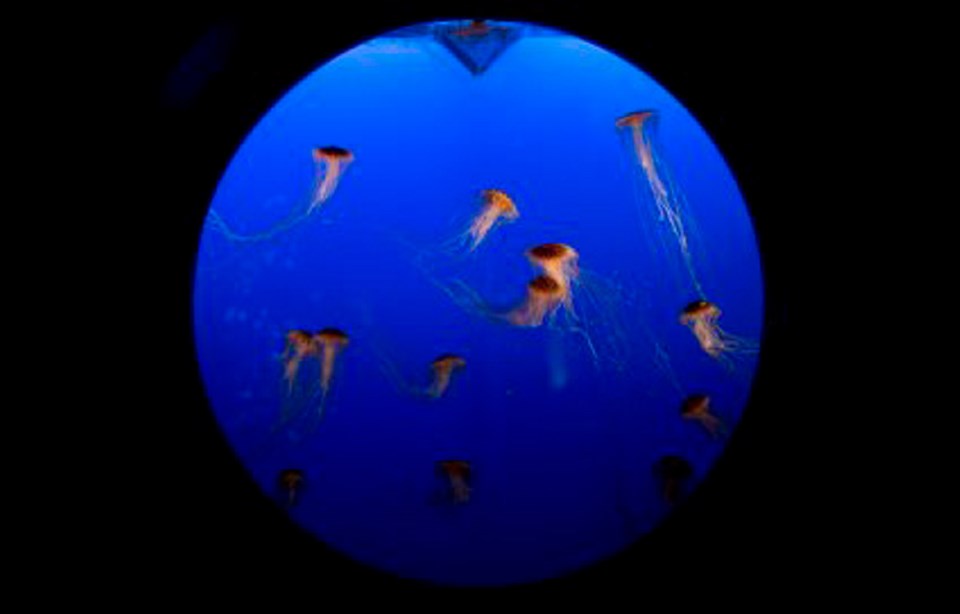SANTA CRUZ, California — The balloon-sized, orange Pacific sea nettles have been conspicuously absent of late from the central California coast’s briny waters.
Swimmers surely won’t miss their nasty sting. But the dramatic population booms and busts of sea nettles and other jellyfish have intrigued researchers at the Monterey Bay Aquarium Research Institute and the University of California, Santa Cruz. And they’ve developed a very Silicon Valley solution to learn more: a website called JellyWatch to monitor jellyfish cameos around the world.
“If somebody sees some weird blob on the beach, I try to figure out what it is so they can learn more about it,” said marine biologist Steve Haddock, a scientist at the institute and adjunct professor at UC Santa Cruz who created JellyWatch.
He’s teamed up with UC Santa Cruz oceanographer Chris Edwards to study just how jellyfish move through global seas.
JellyWatch puts a friendlier face on the oceanic blobs with a smiling jellyfish logo created by Haddock. And while the site is helping the researchers gather data, it’s also becoming a hit with amateur jellyfish fans. The website, which added a multilingual mobile app last year, has amassed almost 5,000 posts from around the world.
“JellyWatch helps amateurs and enthusiasts get an idea of where different jellyfish species are,” said Thomas Nilson, an amateur naturalist from British Columbia who follows the JellyWatch Facebook page and uses its mobile app. Nilson has proposed science-based names for JellyWatch groupies. Among them: “Medusians” and “Anthozoans.”
Haddock began studying the diversity of jellyfish as a graduate student, exploring how some glow and others don’t, how some sting and others don’t, and how some have long, thin filaments for tentacles while others have what look like stocky limbs. But he soon realized that mysterious population booms and busts posed a major obstacle to understanding them. The phenomenon is well documented but mysterious.
“You see all these articles about it,” said Haddock, who has found newspaper articles on the subject dating back to 1905. “People always say, ‘Oh they’re taking over the world.’ ”
Haddock realized he needed to understand jellyfish populations on a global scale. So in 2010, he led a team to create JellyWatch. The website allows anyone in the world to record a jellyfish sighting, with a location, description and photo. Haddock created the platform with dual purposes in mind: to gather data on jellyfish populations and to counteract the creatures’ reputation as an ocean menace.
“Most of the jellyfish people see on the beach are not at all harmful to humans,” Haddock said.
But JellyWatch also is yielding research benefits. The website’s reports in 2014 and 2015, for example, revealed a population burst of Velella — small, blue jellyfish with translucent sails known as “by-the-wind sailors” — along the coast of North America, from Mexico to Alaska. Meanwhile, JellyWatch showed that reports of sea nettles in Monterey Bay have trailed off.
Haddock has a hunch about what drives these capricious populations. Many jellyfish species begin their lives in a “polyp” form, resembling tiny sea anemones. Each species needs its own special water temperature and nutrient mix to bud into a jellyfish, and polyps wait years for the right conditions. When the time comes, they morph into tiny juvenile jellyfish all at once, creating a bloom. These jellyfish mate, but it may be years before the new polyps produce more jellies.
The oceans’ fluctuating currents complicate the picture. Edwards said the mystery of the missing sea nettles might be solved by ocean conditions that carry jellyfish on journeys spanning hundreds of miles over weeks or years.
His lab uses moorings at sea that send out pulses to measure waves, and members of the team use weather vanes to track wind. They feed the data into a supercomputer, which creates a complex model of how jellyfish move through the ocean. Eventually, Edwards said, the model also could track commercially important species, such as Dungeness crab.
Edwards’ lab is still working with Haddock on the model, but for some beachgoers, a model of jellyfish transport can’t come soon enough.
“I don’t like them,” said 10-year-old Alexis Gastrejon as she overlooked the ocean from a seaside bench in Santa Cruz.
“I’m scared. ... Other people who have been stung say it really hurts.”
But others, such as Barbara Williams, said they like jellyfish. Williams swims triathlons and has been stung in the process. Still, she said, “I think they’re part of the marine habitat.”
And that, according to Haddock, is the right attitude. The ocean always will be home to jellyfish.
“We’re the intruders,” Haddock said, “not the jellies.”



